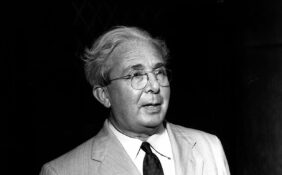Albert Einstein’s Hungarian student who helped creating the atomic bomb: Szilárd Leó

Szilárd Leó (or Leo Szilard) was an American physicist and inventor of Hungarian origin. He was Albert Einstein’s student and collaborator, who played an instrumental role in creating the atomic bomb. An “intellectual bumblebee”, a “pushy Jewish busybody”, “a parasite living on the brains of others” – these are the words of his colleagues. But who was the Hungarian man who took part in the Manhattan project so actively and was still left out of its official history?
Early Life

Leó Szilárd was born on February 11, 1898, in Budapest, Hungary (back in the day it was Austro-Hungary). As a child, he was already specific, for example, if he was asked to close the windows because it was cold outside, he always made the point that closing the window would not raise the temperature outside. Nevertheless, it was already seen that he was cleverer than most of his peers. His father was a civil engineer, and Szilárd followed his footsteps in 1916 and started his studies as an engineering student at a technical university in Budapest. After a year only, he joined the Austro-Hungarian army. While the war was still raging in 1917, he escaped the frontlines due to an illness. After the war, he returned to school first in Budapest, then in 1920, he transferred to the Technische Hochschule in Charlottenburg, Germany. But soon he switched schools again, having gotten bored with engineering, and started attending Friedrich Wilhelm University in Berlin, where he studied physics. Here Albert Einstein, Max Plank and Max von Laue (both Nobel prize winners in physics) were his professors.
Szilárd Leó Collaboration with Einstein
Szilárd earned his Ph.D. in physics at University of Berlin in 1922. He wrote his thesis with von Laue as his adviser, which explored thermodynamics, or the study of the physics of heat. Soon he started working as a research assistant to von Laue at the Institute for Theoretical Physics for several years. He also collaborated with Einstein between 1926 and 1930 on a type of home refrigerator, later known as the Einstein refrigerator or the Einstein-Szilard refrigerator. They were motivated by contemporary newspaper reports of a Berlin family who had been killed when a seal in their refrigerator failed and leaked toxic fumes. They worked out a device with no moving parts.
He left Germany in 1933, due to the rise of the Nazi Party. He went to Vienna for some time and then arrived in London in 1934, where he worked at St. Bartholomew’s Hospital. Here he conducted experiments on chain reactions. Though he did not find the chain reaction he was searching for, he did find a way to separate isotopes, or special parts, of certain elements.
Atomic Energy Research
In Oxford, he worked on nuclear physics in the Clarendon Laboratory. He tried to convince other physicists, including Enrico Fermi, about the possibility of harnessing atomic energy as well as to warn them about its potential dangers. While in England he discovered a means of isotope separation known as the Szilard–Chalmers effect.
Foreseeing another war in Europe, Szilard moved to the United States in 1938, where he worked with Enrico Fermi and Walter Zinn on means of creating a nuclear chain reaction. He was present when this was achieved on December 2, 1942. At the same time, he was said to be very lazy: he refused to help Fermi and his team stacking graphite bricks for the chain reactions experiment. He rather slept more and started the day with a long bath, while contemplating on new ideas.

The Manhattan Project
In 1939, he and the physics community were concerned over the discovery of nuclear fission by Otto Hahn and Fritz Straussmann in Germany, so they convinced Albert Einstein to write President Franklin D. Roosevelt about building the atomic bomb. With the Nazis trying to take over Europe, they were concerned about what would happen if the Germans developed the bomb first.
Roosevelt decided to start the Manhattan Project in 1942. It was led by Robert Oppenheimer and it sought to transform atomic energy for military purposes. Szilárd became a part of the famed Manhattan Project, but having seen the destructive force of the atomic bomb, Szilard was forever changed. He decided to join the Emergency Committee of Atomic Scientists, an international organization which wanted to prevent further military use of atomic energy. For the rest of his life, Szilard worked on nuclear safety and arms control. He started the Council for a Livable World in 1962, which is still dedicated to reducing the threat posed by nuclear weapons.
Leó Szilárd died on May 30, 1964, in La Jolla, California.
we recommend to your attention Microsoft AZ-900 Practice Tests Dumps
Featured Image: Wikicommons by University of Chicago. Leo Szilard: middle row, second from right
Source: www.nytimes.com/, www.biography.com






There were more than one Hungarian in the main core who were responsible for the creation of the bombs. Van Neumann, Teller, Wigner, Szilard.
Correction; there were 5 martians, Theodore von Kármán, Leo Szilard, Eugene Wigner, János von Neumann, and Edward Teller 🙂
Correct. I forgot the fifth-I knew I was missing one. Thanks for refreshing my memory.